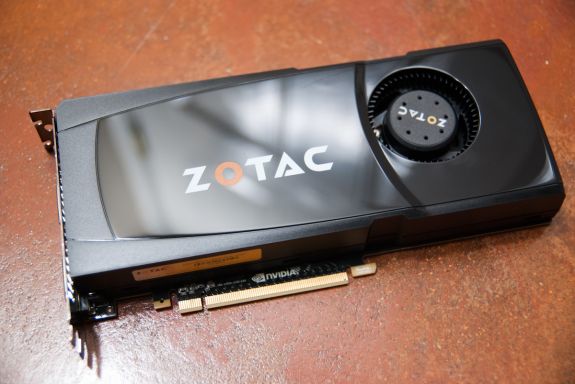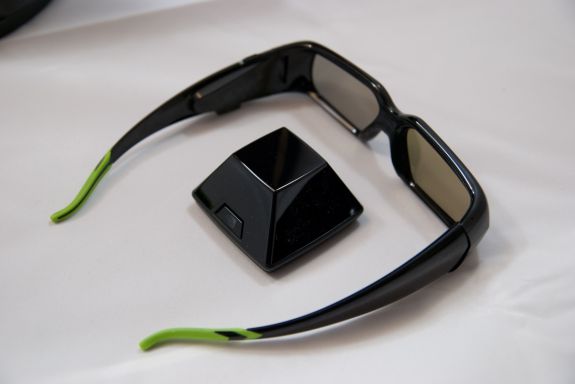ASUS VG236H 23-inch 3D Display Review: 120Hz is the Future
by Brian Klug on August 7, 2010 2:48 AM EST3D Vision on the VG236H
So let’s talk about 3D for a bit before going into the deep bits of the display’s performance. We’ve already covered NVIDIA’s 3D Vision here, but this review would just be incomplete without discussing how much I’ve changed my mind about 3D after playing with the VG236H.
First off, the NVIDIA 3D Vision kit itself is unchanged, though the packaging is a bit more compact. Inside is a soft cloth bag for the classes, two different nasal guides for comfort, two different length USB cables, the IR base station pyramid, shutter glasses, and demo and driver CDs. It feels like a high end product, with the base station pyramid and glasses sitting in foam cutouts, and the requisite accessories in a compartment above.
Additionally, you’ll need a 3D Vision compatible GPU, and can only drive 120Hz refresh rates over DVI-D, not HDMI. Because you’re rendering twice the frames (one for each eye), you’ll take a framerate hit for enabling 3D, so that GPU best be powerful. Zotac graciously supplied their ZOTAC GeForce GTX 470 for testing, which worked perfectly in my testbench.
I noted before that I’ve been skeptical about mainstream 3D gaming for some time now. I’ve seen my fair share of 3D content - though not as much as most of the other AnandTech writers that experienced it at CES on myriad displays - but have an above average grasp for the tech thanks to my optical sciences background.
That out of the way, most of the shutter or polarization based methods I’ve seen up until now suffered from being flickery. Refresh rate just wasn’t high enough, and the result was that I could detect individual frames when moving my head or really looking for it. In theaters, I tried the circularly polarized passive RealD system, and another IMAX 3D system using linear polarization. I had also tried a number of active LCD shutter systems on LCD TVs. While impressive, all of them had noticeable flicker.
The VG236H is the first 3D implementation I’ve played with that doesn’t have noticeable flicker. It just doesn’t. I was immediately impressed with the NVIDIA 3D Vision setup.
NVIDIA thankfully has a pretty comprehensive list of 3D Vision games and how good they perform with the whole system. At the top of the scale is 3D Vision Ready, meaning the game has basically been developed from the start to be viewed in 3D or 2D. Down the list is excellent, good, fair, poor, and not recommended. I first tried a number of ‘good’ titles, and found that while the 3D experience indeed worked, but often small things got in the way.













121 Comments
View All Comments
mino - Tuesday, August 10, 2010 - link
.. reasonable 1920x1200 ..dingetje - Saturday, August 7, 2010 - link
I will immediately get one....when 1920 x 1200 models are available.A 1920 x 1080 screen is just not acceptable for me, even when it's 120hz goodness.
Looking forward to more 120hz screen reviews....thx
Taft12 - Saturday, August 7, 2010 - link
How long can you hold your breath? I don't think 1920x1200 is coming back on the market ever again.ZoZo - Sunday, August 8, 2010 - link
You may have to wait a long time.It appears that 16:10 is being abandoned.
DarkUltra - Sunday, August 8, 2010 - link
For now, yes but if there is a market for it it will hopefully return. The 23" 16:9 we have at works is just too wide for me; the 1920x1200 24" my father have is really much higher, it can fit an entire Windows 7 double-sized task bar and a ribbon menu more than 1080.martin5000 - Saturday, August 7, 2010 - link
16:9 is absolutely horrible for computers. Its so disappointing that this is the current trend.Glossy is also terrible, maybe the colours do look a bit more vibrant, but at the cost of not actually be able to see the screen unless you're in the perfect light conditions, no thanks!
medi01 - Saturday, August 7, 2010 - link
I second that. Basically it's all about marketing:1) glossy screens probably look better in shops
2) X inches monitor with 4:3 ratio has 12% more pixels than 16:9 => it's cheaper to produce
Mr Perfect - Saturday, August 7, 2010 - link
I imaging that being able to put "FULL 1080P HD!" on the box doesn't hurt sales either.So, to recap, change this into a 16:10, matte finish, IPS panel.
BansheeX - Sunday, August 8, 2010 - link
You're both nuts. No aspect ratio inherently gives more resolution than any other. Case-in-point, 3200x1800 is a 16:9 resolution that is much higher than 1600x1200 (4:3) or 1920x1200 (16:10). The reason 1920x1080 is so common for 16:9 is mainly the result of established manufacturing processes and 1:1 scaling of HD material.Quidam67 - Sunday, August 8, 2010 - link
I genuinely don't understand why some people are showing such a strong reaction against 16:9 monitors. I must be missing the point, or is it really just the slightly different aspect ratio + slightly less pixels that has them all worked up?!?